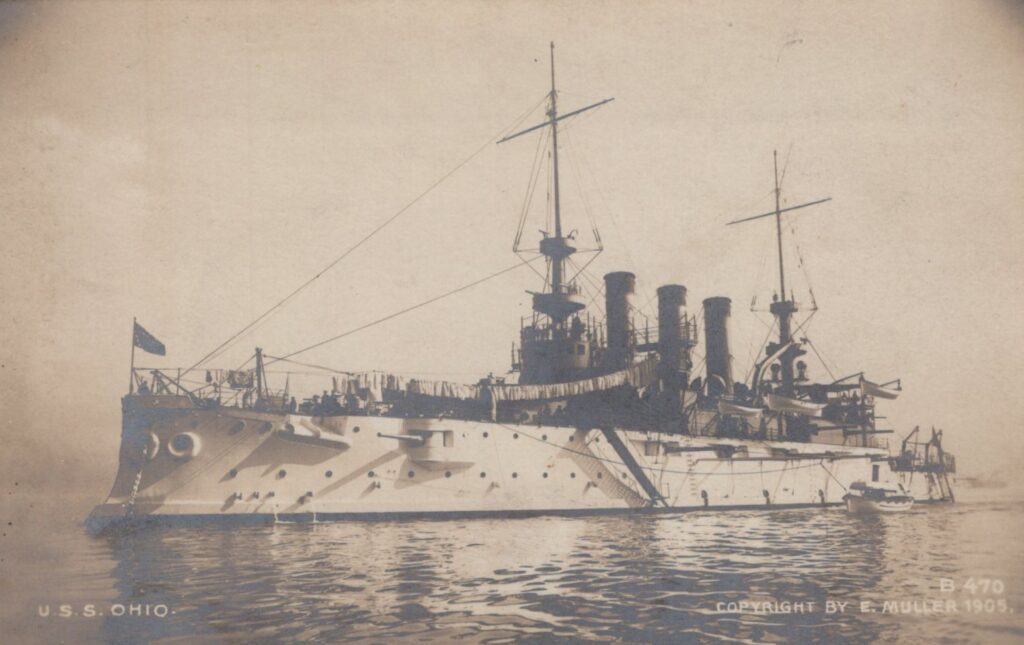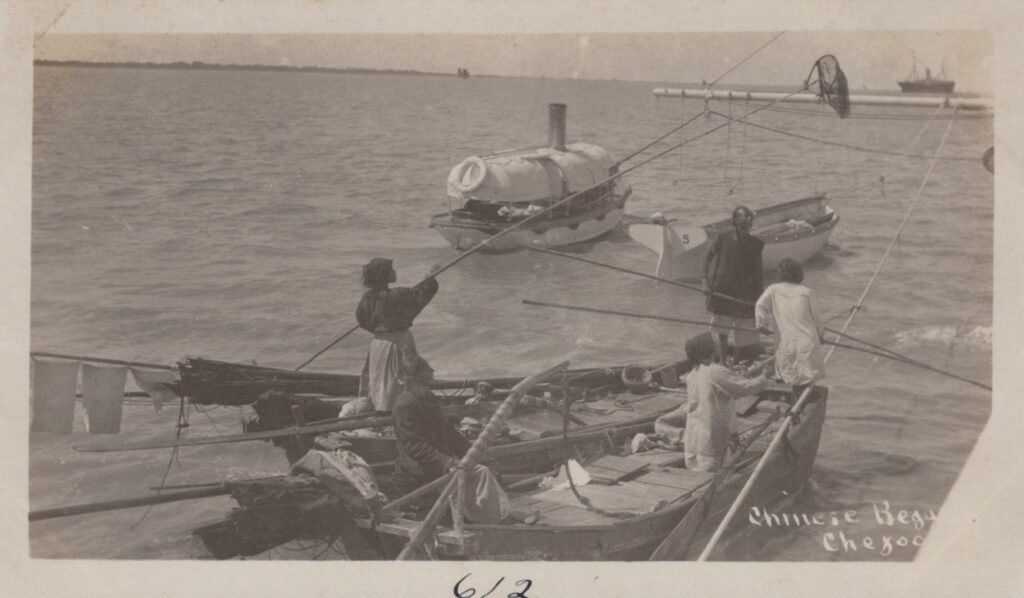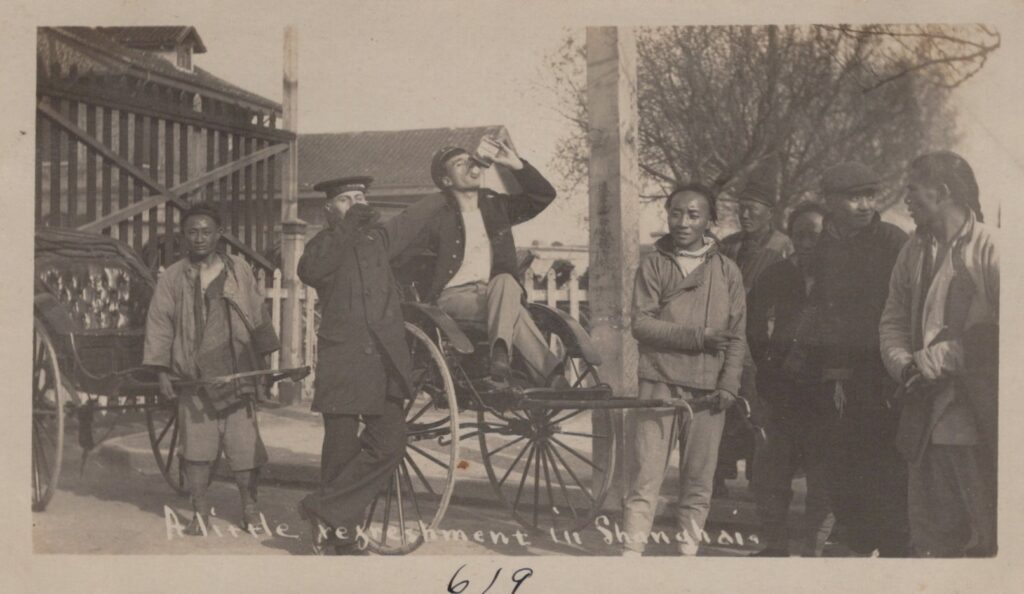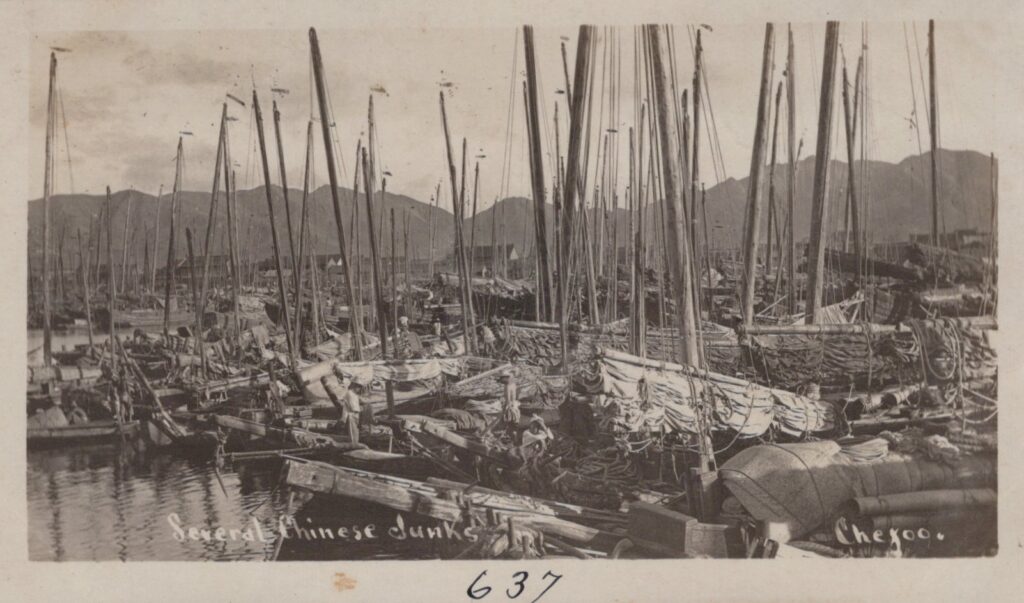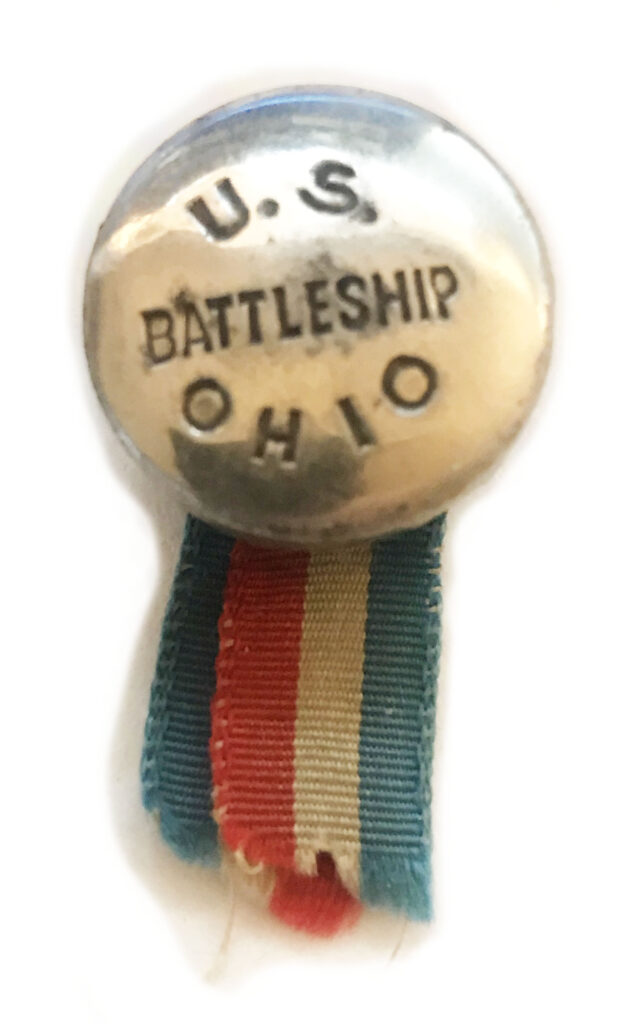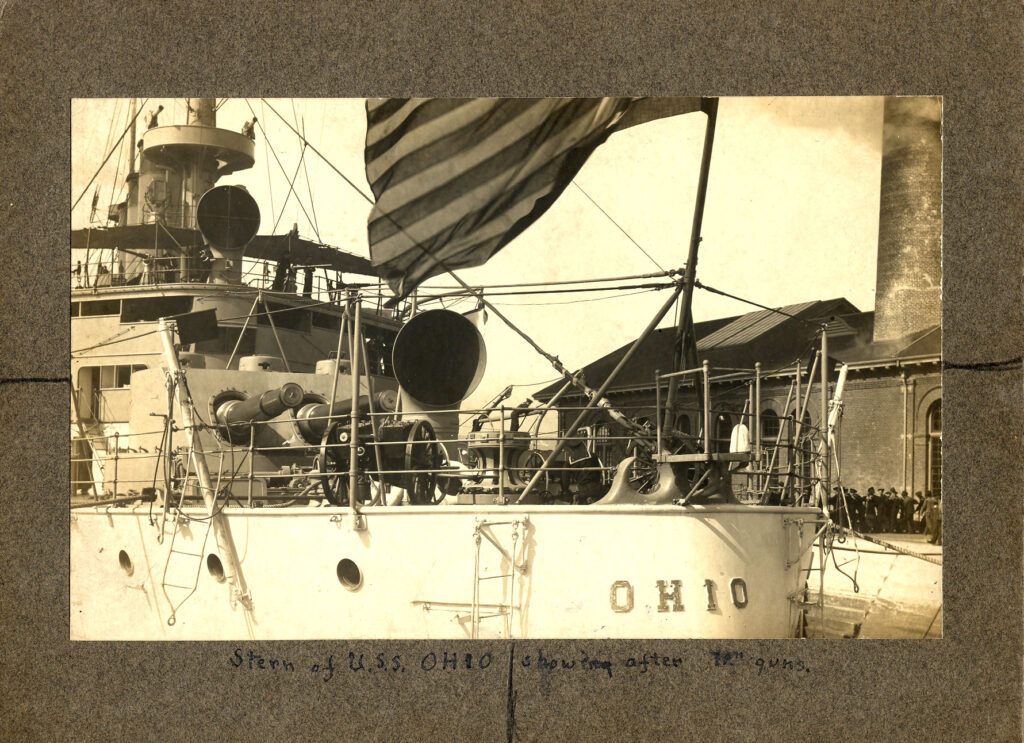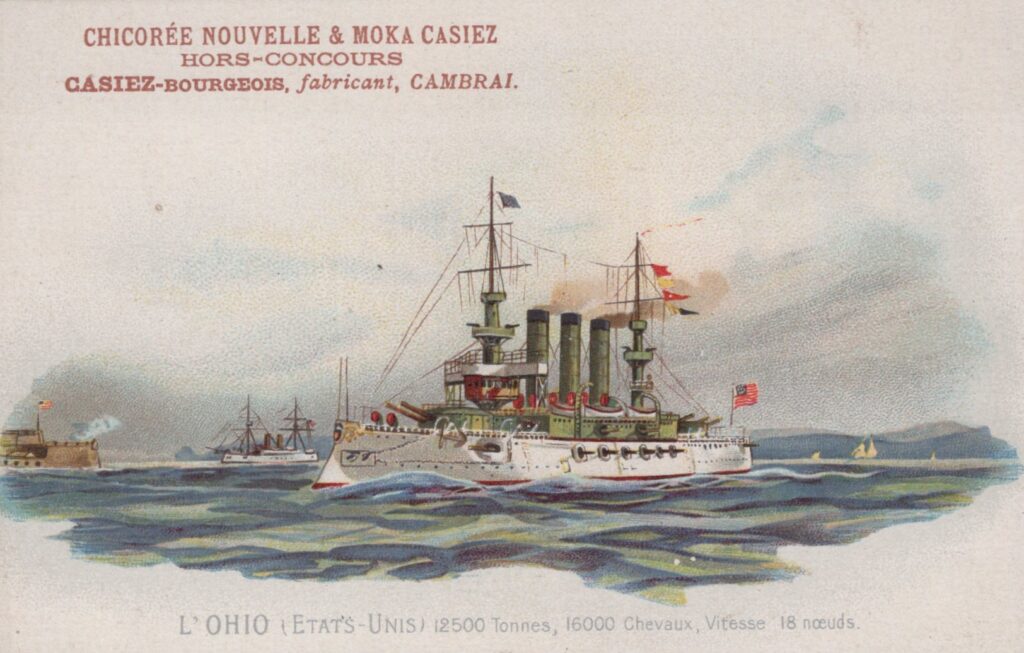Apologies, but no results were found for the requested archive. Perhaps searching will help find a related post.
The USS Ohio (BB-12) was a Maine Class battleship built by Union Iron Works Shipyard in San Francisco. The keel was laid down in April 1899, launched in May 1901, and commissioned in October 1904. She was sponsored by Miss Helen Deschler, and the first Captain was Leavitt C. Logan. After entering service she became the Flagship for the Asiatic Fleet, leaving San Francisco on April 1st, 1905 for Manila. After her arrival, Secretary of War William Taft came onboard to receive a tour of East Asia including visits to Japan and China. She returned to the United States in 1907 and became part of the Atlantic Fleet, participating in the Naval Review by President Roosevelt at the Jamestown Celebration.
At left is a ribbon made by Walter N. Brunt Company of San Francisco for the Launching of the Battleship Ohio on May 18th, 1901. Above the image of the Ohio is "The Ohio Society of California" which was probably an organization formed to support the construction of the Ohio at Union Iron Works.
The photo postcard at right was taken by Enrique Muller. To see more of this collection follow this link: Enrique Muller Photographers
One of the responsibilities the Ohio was assigned was to bring home the body of Rear Admiral Charles J. Train who had died on August 4, 1906 while in command of the Asiatic Fleet. Admiral Train had become commander-in-chief of the Asiatic Fleet in March of 1905 and involved in the ending days of the Russo-Japanese War escorting three fleeing Russian cruisers into Manila Bay. A memorial service was held in China, on the Battleship Ohio with the cruisers Chattanooga and Raleigh and gunboat Elcano were present. These ceremony was directed by the executive officer of the Ohio, Commander W. C. Cowles, later in command of the Kentucky during the world cruise. Japanese Admiral Heihachiro Togo was represented by his aid Lieutenant Commander Count Sano, and other dignitaries from Japan and the United States were present. The body was transferred by the steamer Empress of China, carried out of the harbor, and transferred to the USS Ohio which sailed for Washington D.C. Train is buried at the United States Naval Academy Cemetery at Annapolis. Above left, the draped casket of Admiral Train on the deck of the USS Ohio. Above right, sailors debarking liberty boats in Chefoo for the funeral services for Admiral Train. His son, LT Charles Train, had been taken hostage by a local Chinese mob after an incident where a group of American Officers accidently shot a Chinese woman while hunting pheasant. LT Train successfully extricated himself from the incident with the support of the Marines. The photograph above left, the draped casket of Admiral Train on the Deck of the Ohio; Center, the USS Ohio decorated for the funeral services, right, motor launches loaded with sailors participating in the ceremonies. The center photograph in the center is part of the Frank Lesher Collection on this website, the two other photographs are part of the Brown & Shaffer Collection on this website.
The uss ohio in china
While flagship of the Asiatic Fleet, Ohio spent much of her time in ports of China. The photographs below were taken by two musicians attached to the Ohio, Brown and Shaffer. These musicians, who started a business in photography, would take photographs on the ship, and ashore, creating numbered photographs that could be sold and printed for other sailors. At the bottom of each image is a hand written number that was used to order selected photographs. This can also be seen in the two photographs of the transfer of Admiral Train's body above.
On December 17, 1907 she departed Hampton Roads with Captain Charles Bartlett in Command as part of Second Squadron, Third Division. After San Francisco Captain Howard took command of Ohio. Roosevelt had determined to advance officers with more time left in the Navy and Captain Bartlett was due to retire in 1912. Ohio was part of the Second Squadron during the cruise and visited Amoy, China. Later, in the Mediterranean, she was one of two ships to visit Greece and Turkey.
AFTER THE WORLD CRUISE
After returning from the cruise she proceeded to New York where she was based for the following 4-years doing routine training, exercises, and maintenance for the New York Naval Militia. In 1914 with the rebellion in Mexico, Ohio was sent to protect American interests, afterwards she was transferred to the reserve fleet completing training for midshipman in 1915 and 1916. On April 6, 1917 the United States declared war on Germany and Ohio was recommission on the 24th. During the war she was involved in gunnery practice along the Atlantic seaboard. After the war she was involved with an early experiment in radio-controlled target-ship use. Ohio controlled the former battleship Iowa using radio signals on a voyage from Philadelphia to Hampton Roads in August 1920. In June 1921 the two ships were used off the Virginia Capes. Following the 1922 Washington Naval Treaty limiting the size of navies, Ohio was stricken and sold for scrap on March 24, 1923.
At right are a pair of aluminum salt and pepper shakers with the flag and the USS Ohio emblem. These were probably sold as souvenirs during 1908 in San Francisco, possibly Hampton Roads. Below is a small notepad carrier made out of aluminum, hand-engraved on one side with an eagle, the flag, and USS Ohio, on the other side a printed image of the USS Ohio.
hors-concours
At right is a French advertising card showing the USS Ohio depicted underway. Google translates, "Out of Competition, New Chicory & Mocha Casiez, Casiez-Bourgeois Manufacturer, Cambrai
This company produced and sold chicory (endive) in a can and must have been very popular. The advertising cards included may subjects including military ships of the world.
hunter's point shipyard
These two photographs were taken while Ohio was in dry dock at Hunter's Point, San Francisco, probably in July 1904. These are both high resolution cabinet photos providing good detail of the ship.



